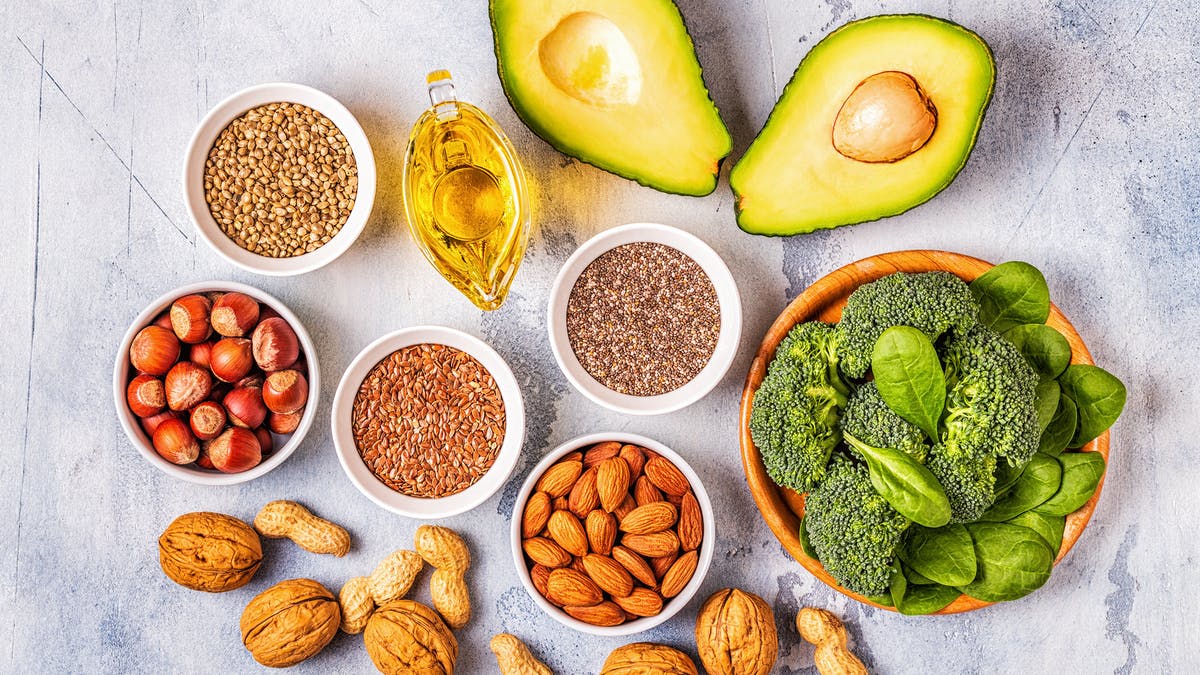 You’ve probably heard or read the word fiber many times in connection with healthy nutrition. And also that you should eat around 30 grams of it a day. The question is: What exactly is dietary fiber and which foods contain the most of it?
You’ve probably heard or read the word fiber many times in connection with healthy nutrition. And also that you should eat around 30 grams of it a day. The question is: What exactly is dietary fiber and which foods contain the most of it?
What are dietary fibers?
Dietary fibers are indigestible food components (fibrous substances) from plant sources such as fruit, vegetables or cereals. In the large intestine, dietary fiber is partially broken down by intestinal bacteria. A distinction is made between the following two groups:
- Water-soluble dietary fibers can be broken down by intestinal bacteria and serve as “food” for them. They are mainly found in fruit and vegetables. In addition to fatty acids and acetic acid, numerous gases are produced during decomposition, which can cause flatulence.
- Water insoluble dietary fiber cannot be decomposed by bacteria and are excreted undigested. However, due to their high swelling capacity, they increase the volume of bowel movements and thus support healthy intestinal activity. They are mainly found in cereal products such as oatmeal or wholemeal pasta.
Why is dietary fiber so important?
A diet rich in fiber has a positive effect on your digestion. However, there are many other benefits:
- Dietary fiber binds harmful substances: In addition to fat, bile acid and cholesterol, dietary fiber can also bind harmful substances to itself, allowing them to be easily excreted by the body.
- Healthy intestinal flora: With water-soluble fiber, you “feed” the trillion vital bacteria that live in your gut. The decomposition processes produce short-chain fatty acids, which have a positive effect on your health, for example on your immune system.
- Cholesterol-lowering: Due to the fiber, on the one hand, the liver produces less of the body’s own cholesterol. Also, by binding bile acid, less fat can be broken down, which results in your body absorbing less fat from your diet. In addition, dietary fiber thins the food pulp, which means less fat comes into contact with the digestive surface of the small intestine. Means less fat is absorbed by your body.
- Reduced risk of obesity: People who eat a lot of dietary fiber have a lower risk of obesity, according to the German Nutrition Society (DGE) a lower risk of obesity, high blood pressure and coronary heart disease.
- Natural satiator: Due to their high swelling capacity, dietary fiber increases the volume of food, causing the stomach and intestines to expand more, which triggers a quick feeling of satiety. This also delays gastric emptying, which keeps you full for a long time. Perfect if you want to lose weight.
High-fiber foods can also be found in our weight loss nutrition plan because of their good satiety:
Which foods are high in fiber?
Dietary fiber is only found in plant foods. According to the recommendations of the German Nutrition Society (DGE), you should eat around 30 grams a day – at least. No problem with these high-fiber foods.
1. Berries
Berries score points not only because of their high fiber content, but above all because of the secondary plant compounds they contain, which give them their bright colors, among other things. Main representatives: Carotenoids, anthocyanins and polyphenols, which are antioxidants that protect your body from harmful effects and are thought to work against cardiovascular disease and diabetes.
Overview of the fiber content of various berry fruits per 100 grams:
- Blueberries: 5 grams
- Raspberries: 5 grams
- Blackcurrants: 7 grams
- Red currants: 4 grams
- Strawberries: 2 gram
2. Oatmeal
100 gamm of oatmeal has 370 calories – it’s not low calorie, but don’t panic: Oatmeal is still absolutely recommendable, for athletes as well as for weight loss enthusiasts. That’s because the insoluble fiber keeps you full for a nice long time, as it swells up in your stomach. Therefore, drink plenty of fluids when you eat high-fiber foods!
Oatmeal is also one of the best sources of magnesium (134 grams per 100 grams). The mineral protects you from muscle cramps and improves your ability to regenerate after sports. The carbs contained also provide you with plenty of energy for your workout. How to make a protein porridge out of the flakes, you can find out here.
3. Quinoa
Quinoa is not only a good source of fiber, it also provides high-quality vegetable protein, making it a great source of protein for vegans and vegetarians. In addition, the gluten-free pseudocereal contains plenty of magnesium and lysine: The mineral magnesium has a key function in muscle contraction and the amino acid lysine is an extremely important muscle and protein building block.
4. Nuts
The high protein content and B vitamins in nuts ensure strong nerves and a good mood. You also need strong nerves when looking at the calorie and fat content: A 40-gram portion of nuts provides around 30 grams of fat and up to 300 calories. But the many unsaturated fatty acids are even healthy for the heart, blood vessels and circulation. You can find a comparison of all nut types in terms of calories and fat here.
Overview of the fiber content of various nuts per 100 grams*:
- Almonds: 15 grams
- Peanuts: 11 grams
- Macadamia: 11 grams
- Pecans: 9 grams
- Hazelnuts: 8 grams
- Cashews: 3 grams
- Walnuts: 6 grams
5. Apples
Probably the best known dietary fiber is pectin, which is hidden in apples directly under the skin (so it is best not to peel them)!). It acts as a natural appetite suppressant, as the swelling fiber signals satiety. An apple provides 3 to 4 grams of dietary fiber (depending on size).
6. Mushrooms
Mushrooms are also excellent sources of fiber and can be prepared in a variety of ways in the kitchen. Besides mushrooms, you can also eat oyster mushrooms, herb mushrooms, porcini mushrooms or morels. All types of mushrooms are low in calories and carbohydrates, contain a lot of vegetable protein and, in addition to plenty of “ballast”, provide important B vitamins that strengthen your nervous system and reduce stress.
7. Cabbage vegetables
The cabbage family are real health boosters, because they not only contain a lot of fiber, but also the mineral and vitamin combination is impressive: Potassium, calcium and blood-forming iron as well as vitamins from the group of B vitamins, vitamin K and vitamin E are found in cabbage vegetables. Broccoli and cabbage are also very rich in vitamin C. These vegetables even contain more of it than oranges or lemons.
Overview of the fiber content of various cabbage varieties per 100 grams:
- Broccoli: 3 grams
- Cauliflower: 3 grams
- Brussels sprouts: 4 grams
- White cabbage: 3 grams
- Chinese cabbage: 2 grams
- Kale: 4 grams
- Kohlrabi: 2 grams
8. Sauerkraut
Although sauerkraut is indirectly counted as a cabbage vegetable, since it is made from white cabbage, we think it deserves a special place in our list, because it scores twice in terms of health: In addition to the fiber it contains (4 grams per 100 grams), sauerkraut also contains lactic acid bacteria, which are produced naturally during production (fermentation). And they have a probiotic effect, stabilizing your intestinal flora, protecting the beneficial intestinal bacteria and fighting the harmful ones.
9. Dried fruit
Dried plums are a popular home remedy for constipation – and this works. For this simply 100 grams dried, unsulphured plums eat throughout the day (best to soak overnight beforehand) or drink prune juice. But eat really only in exceptional cases so much of the dried fruits, because they also contain massive fructose.
Dried figs, apricots or dates are also delicious and contain a lot of fiber, but unfortunately also quite a few calories and as already mentioned fructose – so do not chow down so much on them. 3 to 4 pieces as a snack are ideal.
Overview of the fiber content of various dried fruits per 100 grams*:
- Dried plums: 18 grams
- Dried figs: 12 grams
- Dried apricots: 11 grams
- Dried apple (apple slices): 11 grams
- Dried dates: 9 grams
- Dried cranberries: 6 grams
- Raisins: 5 grams
**1 serving.
10. Bulgur
With Bulgur you bring variety and plenty of satiating fiber to your plate. 100 grams of raw bulgur provide around 9 to 13 grams of it. The “big brother” of couscous is also made from durum wheat semolina and, thanks to gentle processing, is rich in B vitamins, iron and minerals.
11. Wheat bran and wheat germ
One tablespoon alone wheat germ contains 2 grams of dietary fiber, one tablespoon of wheat bran even 3 grams. Germs and bran are best enjoyed pure, for example simply sprinkled over muesli. Bran and germ are a by-product of flour production and also contain minerals and vitamins such as B vitamins, vitamin E, zinc and magnesium.
12. Pears
Pears are good sources of dietary fiber. This is mainly due to their high content of lignin. Lignin is a dietary fiber that helps to break down cholesterol in the intestines. The substance mainly lowers the “bad” LDL cholesterol. One pear provides around 5 grams of fiber.
13. Flaxseed and chia seeds
Although dietary fiber cannot be digested, soluble fiber acts as a natural swelling agent that binds water and ensures a long feeling of satiety. Therefore especially ground flaxseed are considered a miracle weapon against digestive problems: The fiber contained (6 grams per tablespoon) namely stimulates digestion and transports the contents towards the “final destination”.
Also the as Superfood well-known Chia seeds contain plenty of fiber (around 5 grams per tablespoon) and can be used in a similar way to flaxseed, for example as a muesli topping.
14. Whole-grain pasta and whole-grain bread
White flour products (whether bread or pasta) are usually true carbohydrate bombs – the whole grain variety, on the other hand, is really healthy. Whole wheat pasta does not have fewer calories than regular pasta, but when it comes to fiber and protein content, whole wheat pasta has distinct advantages. In fact, a serving of whole-grain pasta (raw weight 100 grams) contains about 12 grams of fiber, a slice of whole-grain bread – depending on the variety – 2 to 5 grams.
15. Legumes
Legumes not only contain plenty of healthy fiber, but also lots of vegetable protein and hardly any fat. They also contain a lot of B vitamins and the mineral zinc, which plays an important role not only in sports but also in sexual performance.
Overview of the fiber content of various legumes per 100 grams:
- White beans: 23 grams (dry product) versus 4 grams (canned)
- Peas: 6 grams (fresh
- Chickpeas: 16 grams (dry product) versus 5 grams (can)
- Kidney beans: 25 grams (dry product) versus 5 grams (canned)
- Lentils: 17 grams (dry product)
- Soybeans: 22 grams (dry product)
- Green beans: 3 grams (fresh
Not so hard to eat a diet rich in fiber or? If you’ve been eating a low-fiber diet, gradually introduce your intestines to small amounts of fiber and drink plenty of it, otherwise the fiber will be hard on your stomach or intestines.
Contents
- 1 What are dietary fibers?
- 2 Why is dietary fiber so important?
- 3 Which foods are high in fiber?
- 3.1 1. Berries
- 3.2 2. Oatmeal
- 3.3 3. Quinoa
- 3.4 4. Nuts
- 3.5 5. Apples
- 3.6 6. Mushrooms
- 3.7 7. Cabbage vegetables
- 3.8 8. Sauerkraut
- 3.9 9. Dried fruit
- 3.10 10. Bulgur
- 3.11 11. Wheat bran and wheat germ
- 3.12 12. Pears
- 3.13 13. Flaxseed and chia seeds
- 3.14 14. Whole-grain pasta and whole-grain bread
- 3.15 15. Legumes

